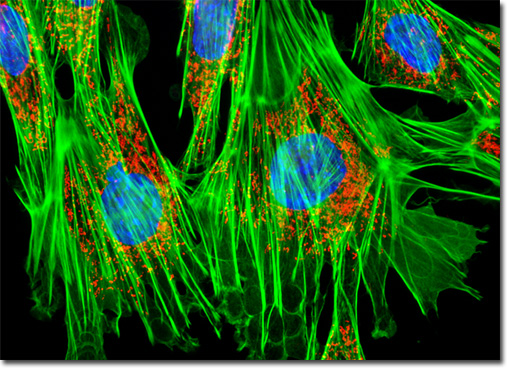Fluorescence Digital Image Gallery
Embryonic Swiss Mouse Fibroblast Cells (3T3)
|
The 3T3 cell line played an important role in enabling human epidermal cells to grow well in culture. Before 1974, the growth of such cells in the laboratory was very limited and unacceptable for most research needs. However, in that year Jim Rheinwald, who was at that time a graduate student, carried out studies on a mouse teratoma that could differentiate into various somatic tissues. When he cultured cells from the tumor, Rheinwald found that, among other varieties of cells, an epithelial cell type with an unusual appearance arose within a colony of teratomal fibroblasts. In the absence of the fibroblasts, these cells grew slowly, but if the culture was supplemented with lethally irradiated 3T3 cells, the epithelial cells grew quickly and the growth of the teratomal fibroblasts ceased. This discovery made it possible to isolate clones of the epithelial cells for study, eventually resulting in the establishment of epidermal cell lines that were supported in culture by 3T3 cells. Indeed, due to this development, keratinocytes, the chief kind of cell that composes the skin, have become one of the most cultivable of human diploid cell types. The log phase culture of embryonic Swiss mouse fibroblast cells presented in the digital image above was stained with MitoTracker Red CMXRos, Alexa Fluor 488 conjugated to phalloidin, and DAPI, which target the intracellular mitochondrial network, cytoskeletal actin filaments, and nuclei, respectively. High signal levels from all three of the fluorophores employed to stain the culture are present. Images were recorded in grayscale with a QImaging Retiga Fast-EXi camera system coupled to an Olympus BX-51 microscope equipped with bandpass emission fluorescence filter optical blocks provided by Omega Optical. During the processing stage, individual image channels were pseudocolored with RGB values corresponding to each of the fluorophore emission spectral profiles. |
© 1995-2025 by Michael W. Davidson and The Florida State University. All Rights Reserved. No images, graphics, software, scripts, or applets may be reproduced or used in any manner without permission from the copyright holders. Use of this website means you agree to all of the Legal Terms and Conditions set forth by the owners.
This website is maintained by our
|
